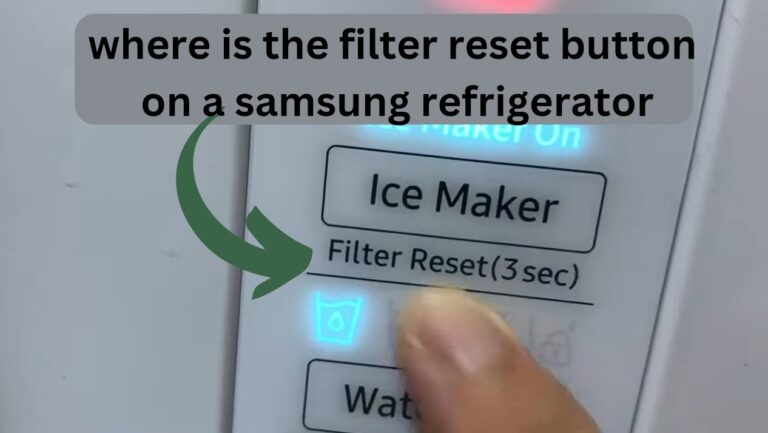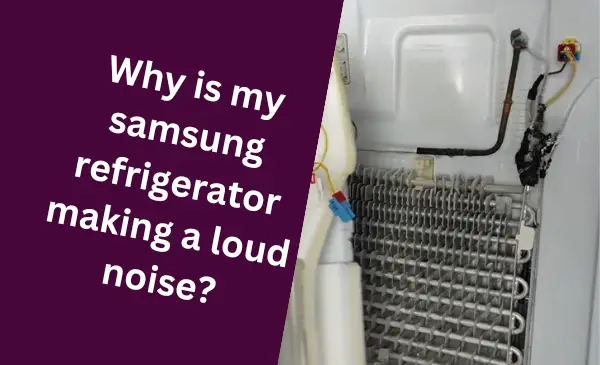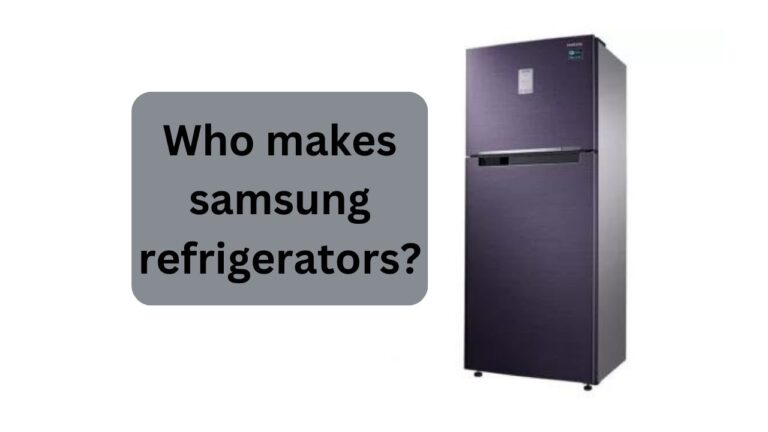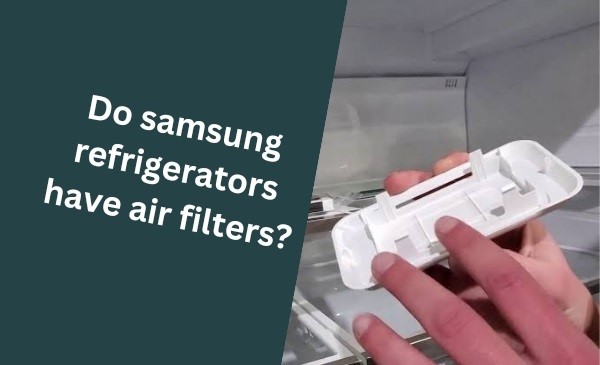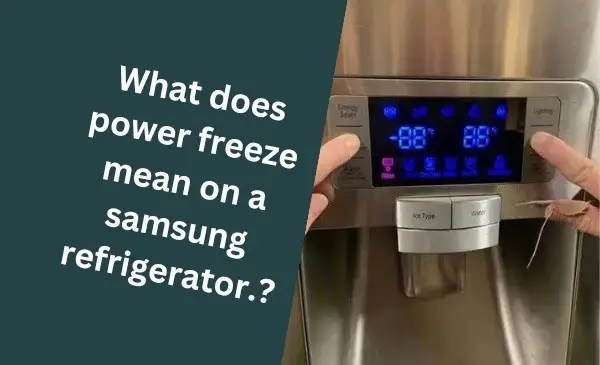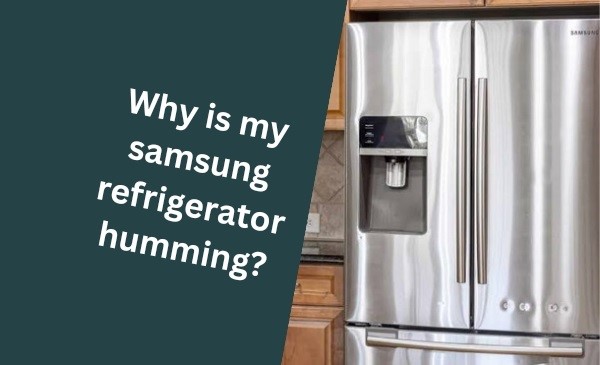The Samsung refrigerator may keep freezing up due to a faulty temperature control or a blocked airflow. In some cases, a malfunctioning defrost timer or thermostat can also cause this issue.
If you’re experiencing freezing problems with your Samsung refrigerator, it’s essential to troubleshoot the temperature control system and check for any obstructions in the airflow.
Regularly cleaning the coils and ensuring proper ventilation can also help prevent freezing issues. By addressing these possible causes, you can resolve the freezing problem and ensure your Samsung refrigerator functions optimally.
Understanding The Freezing Issue
It can be frustrating to open your Samsung refrigerator and find your food items frozen solid, especially when you didn’t intend for them to be stored in the freezer. If you’re facing this issue, understanding the reasons behind your Samsung refrigerator freezing up is crucial. In this section, we will explore common reasons for this problem and how factors like temperature settings and blocked vents can contribute to the freezing issue.
Common Reasons For Samsung Refrigerator Freezing Up
There are several common reasons why your Samsung refrigerator might be freezing up. Identifying these reasons can help you troubleshoot and resolve the issue effectively:
- Faulty temperature control: One of the primary culprits behind a freezing refrigerator is a malfunctioning temperature control system. If the temperature control mechanism is not functioning properly, it can cause the refrigerator to get colder than it should, resulting in frozen items.
- Door seal issues: A faulty door seal allows warm air from outside the refrigerator to enter, leading to excessive cooling. This can cause freezing in certain areas of the fridge.
- Blocked or restricted vents: When the vents of the refrigerator or freezer are blocked or restricted, proper air circulation is hindered. This can result in uneven cooling and the formation of ice in unwanted areas.
- Overpacking the fridge: Stuffing the refrigerator with too many items can obstruct the free flow of air, preventing proper temperature distribution. As a result, certain areas may become colder than needed, leading to freezing.
- Faulty defrost system: A malfunctioning defrost system can cause ice buildup inside the refrigerator, leading to freezing issues. If the defrost system fails to remove accumulated ice, it can lead to excessive cooling.
How Temperature Settings Can Affect Freezing
Temperature settings play a crucial role in preventing freezing in your Samsung refrigerator. When the temperature is set too low, the refrigerator can become excessively cold, causing items to freeze. It is recommended to keep the refrigerator temperature between 37°F and 40°F (or 3°C and 5°C) to ensure optimal cooling without the risk of freezing. Checking and adjusting the temperature settings can often resolve the freezing issue.
Impact Of Blocked Vents On Freezer Temperature
Blocked vents can significantly impact the temperature of your freezer, leading to freezing issues. Vents play a vital role in maintaining proper air circulation within the refrigerator. When vents are blocked by food items, ice, or other obstructions, cold air cannot flow freely, causing uneven cooling and potential freezing in certain areas. Regularly checking and clearing any obstructions from the vents can help maintain consistent refrigerator temperatures and prevent freezing.
Checking The Door Seals
When it comes to maintaining the optimal performance of your Samsung refrigerator, checking the door seals is a crucial step. Proper door seals play a vital role in temperature control, preventing your refrigerator from freezing up and ensuring that your food stays fresh for longer. In this section, we will explore the importance of proper door seals, the signs of damaged or faulty seals, and the steps you can take to clean or replace them.
Importance Of Proper Door Seals For Temperature Control
Proper door seals are essential for maintaining the right temperature inside your Samsung refrigerator. They create an airtight barrier that keeps cold air in and warm air out, preventing any fluctuations that could lead to freezing or spoilage of your food. When the door seals are intact, your refrigerator doesn’t have to work harder to maintain the desired temperature, resulting in better energy efficiency and cost savings.
Signs Of Damaged Or Faulty Door Seals
Identifying damaged or faulty door seals is crucial to ensure the efficient functioning of your refrigerator. Here are some signs to look out for:
- Visible cracks or tears in the door seals
- Resistance when closing the refrigerator door
- Visible condensation or frost on the interior surfaces
- An increase in your energy bills
If you notice any of these signs, it’s important to address the issue promptly to avoid further damage and inconvenience.
Steps To Clean Or Replace The Door Seals
Cleaning or replacing the door seals of your Samsung refrigerator is a relatively simple task that you can do yourself. Follow these steps:
- Start by unplugging the refrigerator from the power source to ensure your safety.
- Inspect the door seals for any visible dirt, debris, or mold. If you notice any, use a mild detergent diluted in warm water to clean them.
- For stubborn stains or mold, you can use a mixture of baking soda and water as a natural and effective cleaning solution.
- Rinse the door seals thoroughly with clean water and ensure they are completely dry before moving on.
- If the door seals are damaged beyond repair, it’s time to replace them. Contact Samsung customer support or check the official Samsung website for replacement parts.
- Installing the new door seals requires carefully following the manufacturer’s instructions. Make sure to place them securely and evenly along the edges of the refrigerator door.
- Once the new seals are in place, plug the refrigerator back in and check for a proper seal by running your hand along the edges of the door. Any resistance or airflow indicates a faulty installation.
By regularly checking the door seals, cleaning them, and replacing them when necessary, you can ensure the optimal performance and longevity of your Samsung refrigerator.
Assessing The Temperature Controls
When it comes to maintaining the optimal temperature inside your Samsung refrigerator, the temperature controls play a crucial role. These controls are designed to regulate the freezer temperature, ensuring that your food stays fresh and properly chilled. However, if you’re experiencing issues with your refrigerator constantly freezing up, it’s essential to assess the temperature controls and make the necessary adjustments to restore optimal performance.
How Temperature Controls Regulate Freezer Temperature
The temperature controls in your Samsung refrigerator are responsible for maintaining the desired temperature in the freezer compartment. These controls work by regulating the flow of cold air into the freezer, allowing you to set the temperature at a level that suits your needs. By adjusting the temperature controls, you can ensure that your freezer maintains the ideal temperature for food storage without freezing up.
Troubleshooting Steps For Temperature Control Issues
If your Samsung refrigerator is consistently freezing up, it may be due to temperature control issues. To troubleshoot this problem, follow these steps:
- Start by checking the current temperature settings on the control panel. Ensure that the freezer temperature is set to an appropriate level, usually around 0°F (-18°C).
- If the temperature settings are correct, examine the temperature control knob or buttons for any signs of damage or malfunction. Sometimes, a faulty control knob or button can cause erratic temperature changes. If you notice any issues, consider replacing the temperature control mechanism.
- Inspect the temperature sensor in the freezer compartment. A defective temperature sensor can also disrupt the proper functioning of the temperature controls. If the sensor appears damaged or defective, it’s advisable to replace it with a new one.
- Ensure that the refrigerator door is sealed tightly. A loose or damaged door seal can cause the freezer temperature to fluctuate, leading to freezing issues. Inspect the door gasket and replace it if necessary.
- Check for any obstructions in the air vents or ducts. Blocked vents can restrict the airflow and interfere with temperature regulation. Clear any debris or ice buildup that may be obstructing the air circulation in your refrigerator.
Adjusting The Temperature Settings For Optimal Performance
To ensure your Samsung refrigerator performs optimally and prevents freezing issues, it’s crucial to adjust the temperature settings correctly. Follow these steps:
- Refer to the user manual or model-specific guidelines provided by Samsung to determine the recommended temperature settings for your refrigerator.
- Access the temperature control panel on your refrigerator and make the necessary adjustments to set the freezer temperature within the recommended range.
- Monitor the temperature regularly and make fine-tuning adjustments as needed, especially during extreme weather conditions or when storing large quantities of food.
- If you continue to experience freezing issues after adjusting the temperature settings, it’s advisable to contact a professional technician for further diagnosis and repair.
Clearing Vent Blockages
Clearing Vent Blockages in Your Samsung Refrigerator
Does your Samsung refrigerator keep freezing up? One common issue that can cause this problem is vent blockages. When the vents in your refrigerator become obstructed, it disrupts the airflow, leading to uneven cooling and a buildup of frost or ice. To prevent this inconvenience, it’s essential to identify and clear any vent blockages in your Samsung refrigerator. In this article, we’ll provide you with a step-by-step guide on how to do just that.
Identifying Common Vent Blockages In A Samsung Refrigerator/h3
Before you can proceed with clearing the vent blockages, you first need to be able to identify them. Here are some common vent blockages you may encounter in your Samsung refrigerator:
- Dust and debris: Over time, dust, pet hair, food particles, and other debris can accumulate in the vents, causing blockages.
- Ice buildup: If the refrigerator’s defrost system is not functioning correctly, ice can accumulate in the vents, obstructing airflow.
- Incorrectly stored items: Sometimes, improperly stored items can accidentally block the vents, preventing proper air circulation.
How Blockages Affect Airflow And Lead To Freezing/h3
When the vents in your Samsung refrigerator are blocked, the airflow becomes restricted. As a result, the cold air from the freezer section cannot circulate properly, leading to freezing in certain areas of the refrigerator. This can cause food to become icy and unusable, and it may also put more strain on the compressor, potentially leading to further issues down the line.
Moreover, the buildup of frost or ice in the vents can exacerbate the blockage, making it even harder for air to pass through. This imbalance in temperature distribution can cause the refrigerator to work harder than necessary, leading to increased energy consumption and decreased overall efficiency.
Steps To Clear Vent Blockages And Ensure Proper Airflow/h3
Now that you understand the importance of addressing vent blockages, let’s delve into the steps you can take to clear them and ensure proper airflow in your Samsung refrigerator:
- Unplug the refrigerator: Before starting any maintenance or cleaning procedures, always remember to unplug your refrigerator to avoid any potential electrical hazards.
- Remove items and shelves: Clear the refrigerator of all its contents, including shelves and drawers, to gain full access to the vents.
- Locate the vents: In a Samsung refrigerator, the vents are typically located at the back wall of the freezer section or along the sides of both compartments.
- Clean the vents: Using a soft-bristle brush or a vacuum cleaner, carefully remove any visible debris or dust buildup from the vent openings. Be gentle to avoid damaging the vents.
- Defrost the refrigerator: If there is ice or frost obstructing the vents, defrost the refrigerator before proceeding with further cleaning. This can be done by turning off the refrigerator and leaving the freezer section door open until all the ice has melted.
- Reassemble and test: Once the vents are cleared and the refrigerator is defrosted, reassemble the shelves and drawers. Plug in the refrigerator and check for proper airflow by monitoring the temperature distribution over a few hours.
By following these steps, you can maintain proper airflow and prevent vent blockages that lead to freezing in your Samsung refrigerator. Remember to perform regular cleaning and maintenance to ensure efficient cooling and extend the lifespan of your appliance.
Dealing With Excessive Moisture
Experiencing frequent freezing in your Samsung refrigerator can be a frustrating ordeal. One of the potential culprits behind this issue is excessive moisture. Excessive moisture can not only affect the efficiency of your refrigerator but also lead to freezing and food spoilage. In this section, we will explore how excessive moisture can contribute to freezing, share some valuable tips for managing moisture levels, and provide effective solutions to minimize moisture and prevent freezing.
How Excessive Moisture Can Contribute To Freezing
Excessive moisture inside your refrigerator is an invitation for trouble. When warm, humid air enters the refrigerator cavity, it condenses on the cooling surfaces, forming frost and ice buildup. This buildup can obstruct the proper functioning of the cooling system, leading to temperature imbalances and, ultimately, freezing.
Tips For Managing Moisture Levels In The Refrigerator
Managing moisture levels is crucial for maintaining an optimal refrigerator environment. Here are some useful tips to help you prevent excessive moisture and control humidity:
- Store food properly: Ensure all food items are tightly sealed or wrapped, as uncovered or improperly sealed items contribute to moisture buildup.
- Check door seals: Regularly inspect the door gaskets for any signs of wear or damage. If the seals are compromised, replace them to prevent warm air from entering.
- Avoid overloading: Overloading the refrigerator can obstruct airflow and lead to increased humidity levels. Organize your groceries efficiently and leave space for proper air circulation.
- Keep fruits and vegetables separate: Certain fruits and vegetables release ethylene gas, which can accelerate ripening and increase humidity levels. To prevent excess moisture, store them separately in designated drawers or compartments.
Solutions For Minimizing Moisture And Preventing Freezing
To minimize moisture and prevent freezing in your Samsung refrigerator, consider implementing the following solutions:
- Adjust humidity settings: Many Samsung refrigerators offer humidity control options. Set the humidity to an appropriate level based on the contents of your refrigerator, ensuring a balance between dryness and excessively moist conditions.
- Regularly defrost: If you notice excessive ice buildup, perform a manual defrosting to remove any accumulated frost. Consult your refrigerator’s user manual for specific instructions on the defrosting process.
- Use moisture-absorbing products: Placing moisture-absorbing products, such as silica gel packets or specialized refrigerator deodorizers, can help combat excessive moisture and prevent the formation of frost and ice.
- Ventilate the area around the refrigerator: Ensure that there is sufficient space around the refrigerator for proper ventilation. Proper airflow helps regulate temperature, reduce humidity, and prevent freezing.
By following these tips and implementing these solutions, you can effectively manage and control moisture levels in your Samsung refrigerator, minimizing the chances of freezing and ensuring the longevity of your appliance.

Credit: www.bobvila.com
Frequently Asked Questions On Why Does My Samsung Refrigerator Keep Freezing Up
Why Is My Samsung Refrigerator Freezing Up?
There can be several reasons for your Samsung refrigerator freezing up, such as a faulty temperature control thermostat, clogged air vents, or improper airflow. It’s important to check if the refrigerator door is closing properly and that the freezer is not overloaded with items.
Additionally, ensure that the refrigerator is set to the recommended temperature settings to prevent freezing.
What Should I Do If My Samsung Refrigerator Keeps Freezing Food?
If your Samsung refrigerator keeps freezing food, try adjusting the temperature settings to a slightly warmer setting. Make sure the vents and air passages inside the refrigerator are not blocked by food items. You can also check the temperature sensor and the defrost system to ensure they are functioning properly.
If the issue persists, it’s recommended to contact a professional technician for assistance.
How Can I Prevent My Samsung Refrigerator From Freezing Up?
To prevent your Samsung refrigerator from freezing up, make sure the freezer is not overcrowded and the vents are not blocked. Avoid placing items in front of the thermostat and maintain the recommended temperature settings. Regularly defrost the freezer if necessary and check for any leaks in the door gasket.
If the issue persists, it’s advisable to have your refrigerator inspected by a professional technician.
Conclusion
To prevent your Samsung refrigerator from freezing up, it’s crucial to address the underlying causes. By ensuring proper airflow, setting the correct temperature, and regularly maintaining the appliance, you can avoid this issue. Additionally, inspecting the freezer door seal, checking for obstructions, and defrosting the unit when necessary will help optimize performance.
Managing this problem promptly will guarantee a longer lifespan for your refrigerator and minimize food waste. Remember, knowledge is key to keeping your refrigerator functioning flawlessly!
Hello Readers, I am Mechanic Shuvo, a seasoned refrigerator solution expert with over 11 years of hands-on experience in the field. Throughout my career, I've dedicated myself to understanding the ins and outs of refrigeration systems, honing my skills as a refrigerator mechanic. My passion for these appliances led me to create the website "refrigeratorsolutionsguide.com," where I aim to share my wealth of knowledge and expertise with others.
Over the years, I've encountered a wide range of refrigerator issues and have successfully resolved them all. From common problems like temperature fluctuations and strange noises to more complex technical issues, I've seen it all. Through my website, I hope to provide practical solutions, insightful tips, and guidance to help you keep your refrigerators running smoothly.


